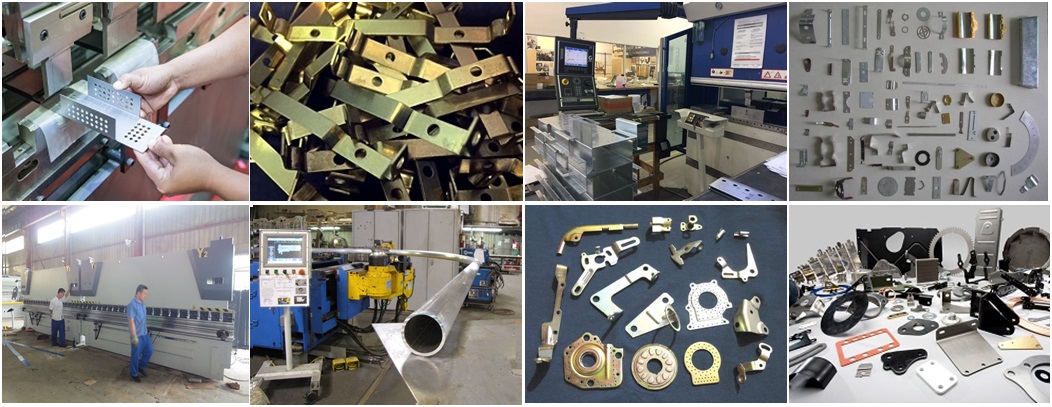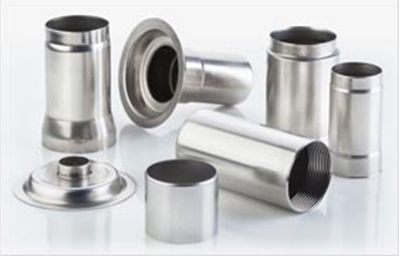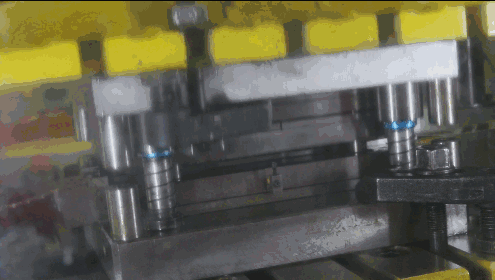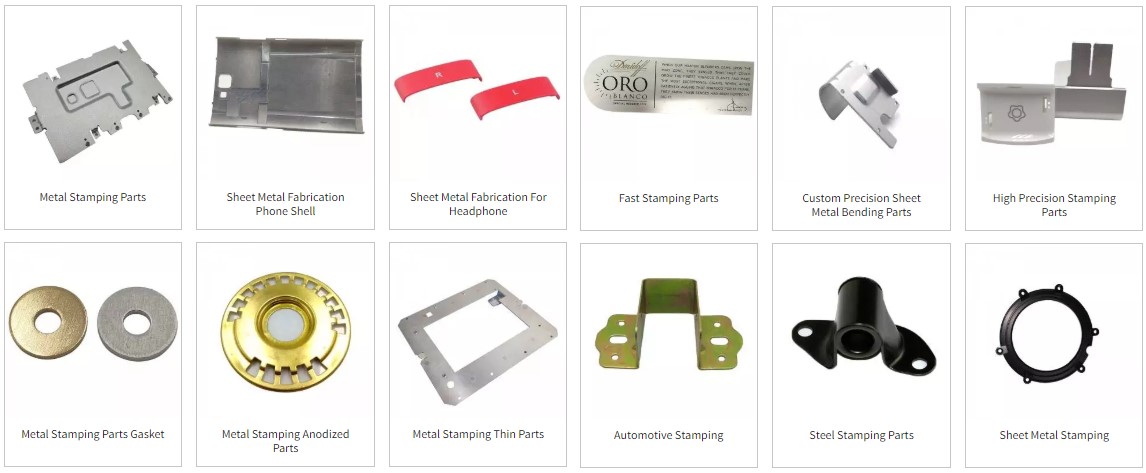
Stamping (also known as pressing) is the process of placing flat sheet metal in either blank or coil form into a stamping press where a tool and die surface forms the metal into a net shape. Stamp-ing includes a variety of sheet-metal forming manufacturing processes, such as punching using a machine press or stamping press, blanking, embossing, bending, flanging, and coining. This could be a single stage operation where every stroke of the press produces the desired form on the sheet metal part, or could occur through a series of stages. The process is usually carried out on sheet metal, but can also be used on other materials, such as polystyrene. Progressive dies are commonly feed from a coil of steel, coil reel for unwinding of coil to a straightener to level the coil and then into a feeder which advances the material into the press and die at a predetermined feed length. Depending on part complexity, the number of stations in the die can be determined. Stamping includes a variety of sheet metal forming manufacturing processes, such as punching, blanking, embossing, bending, tube bending, shearing, flanging and coining.

2. Deep Drawing
 Deep draw manufacturing forms metal into a seamless round, square or rectangular shape called an enclosure, or case. To be considered deep drawn, the height of the case is usually at least two times the diameter. Deep drawn cases are used to enclose technology, especially in demanding environments or whenever tight tolerances and reliability are important. The deep draw process starts when a flat piece of metal, called a blank or disc, is placed over a cavity called a die. A punch then forces the metal through the die, forming it into a shape. These precision punches and dies are known as tooling. The tooling is set up in power presses which produce the tonnage, or energy, needed to force the material through the draw process. During the draw process the material moves into the shape of the die. The flow of material is controlled through pressure ap-plied to the blank and lubrication applied to the die or the blank. Each draw operation is a sepa-rate step and each step reduces the diameter and increases the height of the part. It may take five or more draws, also called reductions, to achieve the final shape. Many factors, including material type and thickness, corner and bottom radii, and shape, determine the number of re-ductions required to make an enclosure.
Deep draw manufacturing forms metal into a seamless round, square or rectangular shape called an enclosure, or case. To be considered deep drawn, the height of the case is usually at least two times the diameter. Deep drawn cases are used to enclose technology, especially in demanding environments or whenever tight tolerances and reliability are important. The deep draw process starts when a flat piece of metal, called a blank or disc, is placed over a cavity called a die. A punch then forces the metal through the die, forming it into a shape. These precision punches and dies are known as tooling. The tooling is set up in power presses which produce the tonnage, or energy, needed to force the material through the draw process. During the draw process the material moves into the shape of the die. The flow of material is controlled through pressure ap-plied to the blank and lubrication applied to the die or the blank. Each draw operation is a sepa-rate step and each step reduces the diameter and increases the height of the part. It may take five or more draws, also called reductions, to achieve the final shape. Many factors, including material type and thickness, corner and bottom radii, and shape, determine the number of re-ductions required to make an enclosure.

3. Progressive Die
 Progressive Die Stamping is a cutting and forming process that utilizes a “Die” that contains a series of stamping stations to perform simultaneous operations on sheet metal that has been supplied on coiled strip. The final metal work piece is developed as the strip of metal is processed through the stamping die. This transformation is performed incrementally, or progressively, by a series of stations that cut and form the material into the desired shape. A Progressive Stamping Die ("Die") is a metalworking device that is designed and built to convert a flat strip of metal raw material into completed parts which conform to print specifications. The Die is placed into a stamping press. As the stamping press moves up, the die opens. As the stamping press moves down, the die closes. The metal moves through the die while the die is open, being fed into the die a precise amount with each stroke of the press. The stamping die can modify the raw material in several ways, such as cutting, bending, coining, shaving, burnishing, extruding, lancing, em-bossing and drawing. When the die closes, the die performs its work on the metal and one or more finished parts are ejected from the die. The finished parts may either be separate (discrete) or connected to a carrier strip and supplied on disposable or returnable reels. The linear travel of the strip stock at each press stroke is called the “feed progression” or “pitch” and is equal to the distance between stations. The unwanted parts of the strip are cut out as it advances through the die and one or more ribbons or tabs (carrier strips) are left connected to each partially completed part to carry it through the remaining stations of the die. In a progressive die, the part remains connected to the stock strip which is fed through the die with automatic feeds and positioned by pilots with speed and accuracy. Since additional work is done in each "station" of the die, it is important that the strip be advanced very precisely so that it aligns within thousandths of an inch as it moves from station to station.
Progressive Die Stamping is a cutting and forming process that utilizes a “Die” that contains a series of stamping stations to perform simultaneous operations on sheet metal that has been supplied on coiled strip. The final metal work piece is developed as the strip of metal is processed through the stamping die. This transformation is performed incrementally, or progressively, by a series of stations that cut and form the material into the desired shape. A Progressive Stamping Die ("Die") is a metalworking device that is designed and built to convert a flat strip of metal raw material into completed parts which conform to print specifications. The Die is placed into a stamping press. As the stamping press moves up, the die opens. As the stamping press moves down, the die closes. The metal moves through the die while the die is open, being fed into the die a precise amount with each stroke of the press. The stamping die can modify the raw material in several ways, such as cutting, bending, coining, shaving, burnishing, extruding, lancing, em-bossing and drawing. When the die closes, the die performs its work on the metal and one or more finished parts are ejected from the die. The finished parts may either be separate (discrete) or connected to a carrier strip and supplied on disposable or returnable reels. The linear travel of the strip stock at each press stroke is called the “feed progression” or “pitch” and is equal to the distance between stations. The unwanted parts of the strip are cut out as it advances through the die and one or more ribbons or tabs (carrier strips) are left connected to each partially completed part to carry it through the remaining stations of the die. In a progressive die, the part remains connected to the stock strip which is fed through the die with automatic feeds and positioned by pilots with speed and accuracy. Since additional work is done in each "station" of the die, it is important that the strip be advanced very precisely so that it aligns within thousandths of an inch as it moves from station to station.  Bullet shaped or conical "pilots" enter previously pierced round holes in the strip to assure this alignment since the feeding mechanism usually cannot provide the necessary precision in feed length. The components of the die that perform opera-tions on the material are unique for every part. These components are located and guided in pre-cision cut openings in plates which are in turn located and guided by pins. The entire die is actu-ated by a mechanical press that moves the die up and down. A press feeding mechanism is also responsible for feeding the material through the die, progressing it from one station to the next with each stroke.The progressive metal stamping process incorporates numerous methods to produce intricate metal parts and components, including punching, coining bending, and more.The progressive metal stamping process begins with a metal strip or metal coil being fed into a stamping press that is divided into multiple ;stations, each with a different stamping tool. As the material moves through the machine, the different tools stretch, cut, or otherwise form the metal into the desired shape, one step at a time. This process is especially suitable for complex metal stamps.
Bullet shaped or conical "pilots" enter previously pierced round holes in the strip to assure this alignment since the feeding mechanism usually cannot provide the necessary precision in feed length. The components of the die that perform opera-tions on the material are unique for every part. These components are located and guided in pre-cision cut openings in plates which are in turn located and guided by pins. The entire die is actu-ated by a mechanical press that moves the die up and down. A press feeding mechanism is also responsible for feeding the material through the die, progressing it from one station to the next with each stroke.The progressive metal stamping process incorporates numerous methods to produce intricate metal parts and components, including punching, coining bending, and more.The progressive metal stamping process begins with a metal strip or metal coil being fed into a stamping press that is divided into multiple ;stations, each with a different stamping tool. As the material moves through the machine, the different tools stretch, cut, or otherwise form the metal into the desired shape, one step at a time. This process is especially suitable for complex metal stamps.

Secondary services
1.Heat treatment to adjust metal physical and chemical properties;
2.Surface treatment: Painting, Powder coating, Zinc plating, Nick plating, Anodizing, Galvanizing, Polishing, etc...
3.Assembly;
4.Customized packaging, oil protection as per needed.
Products

